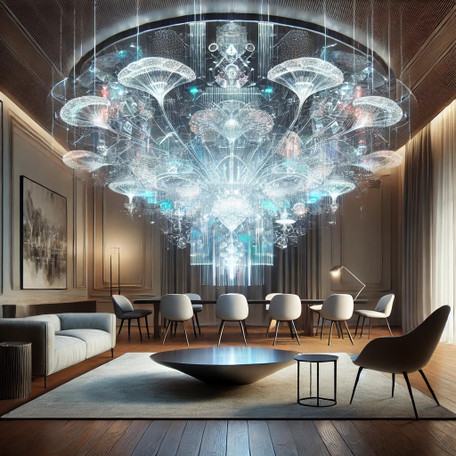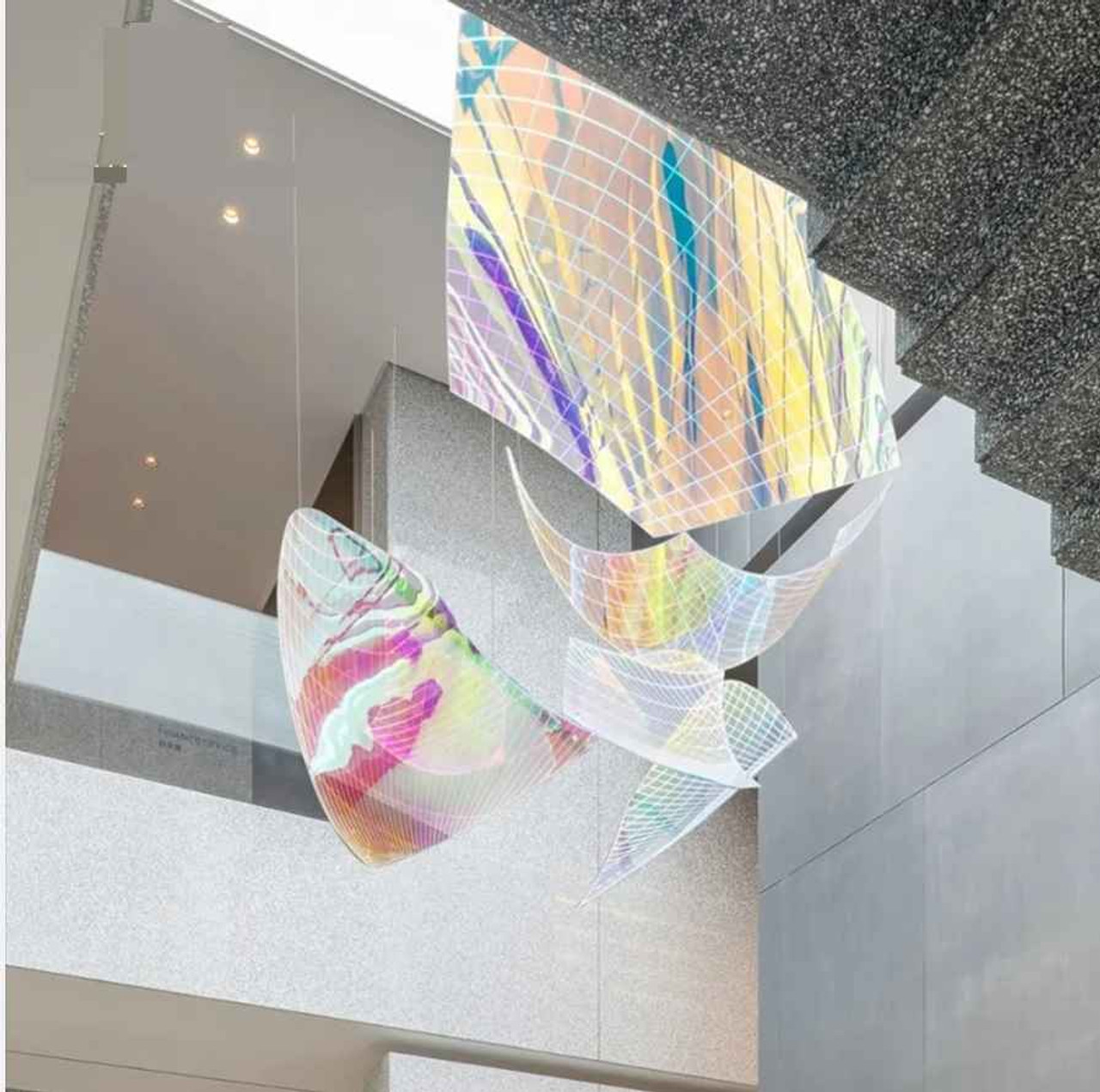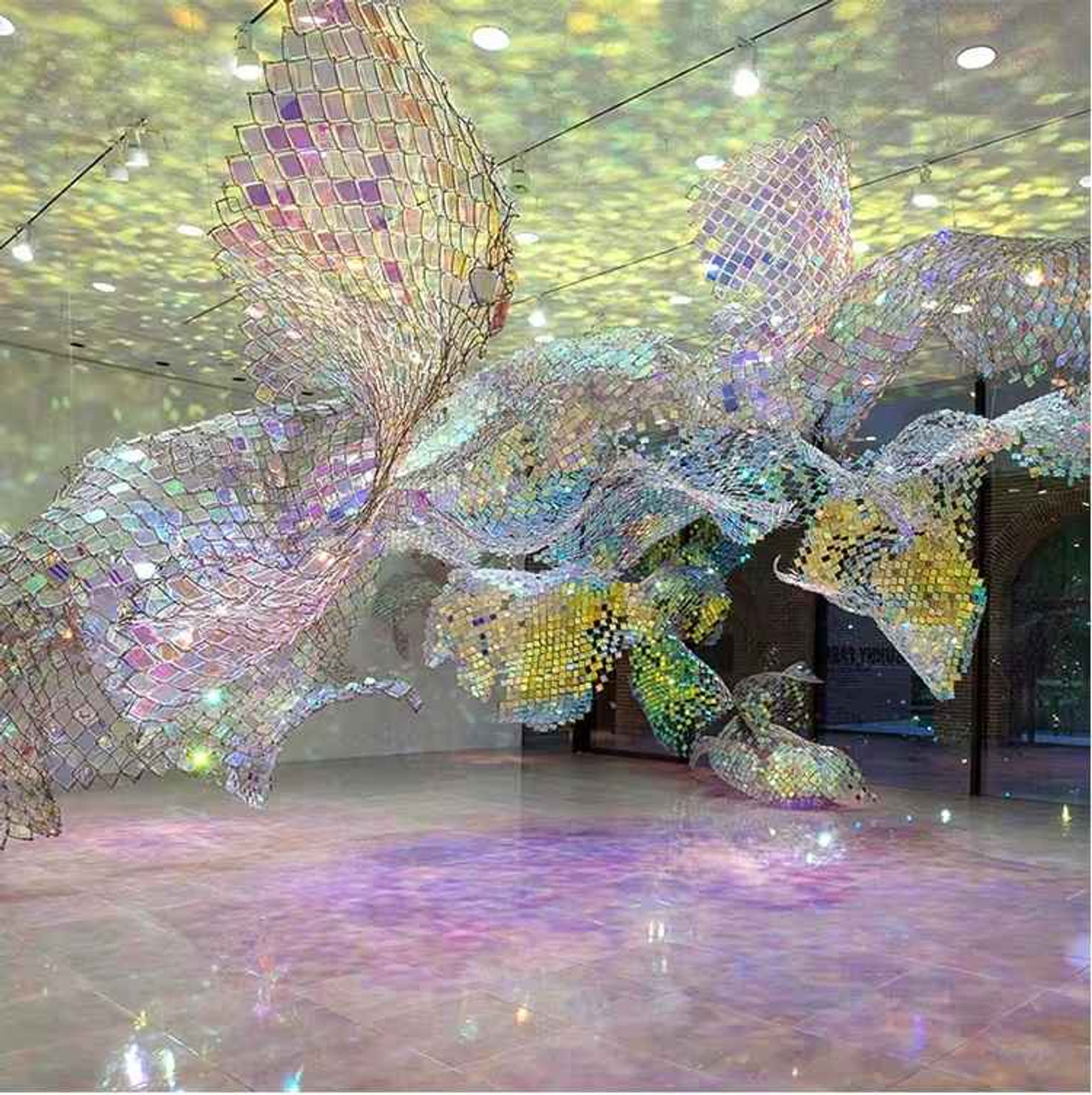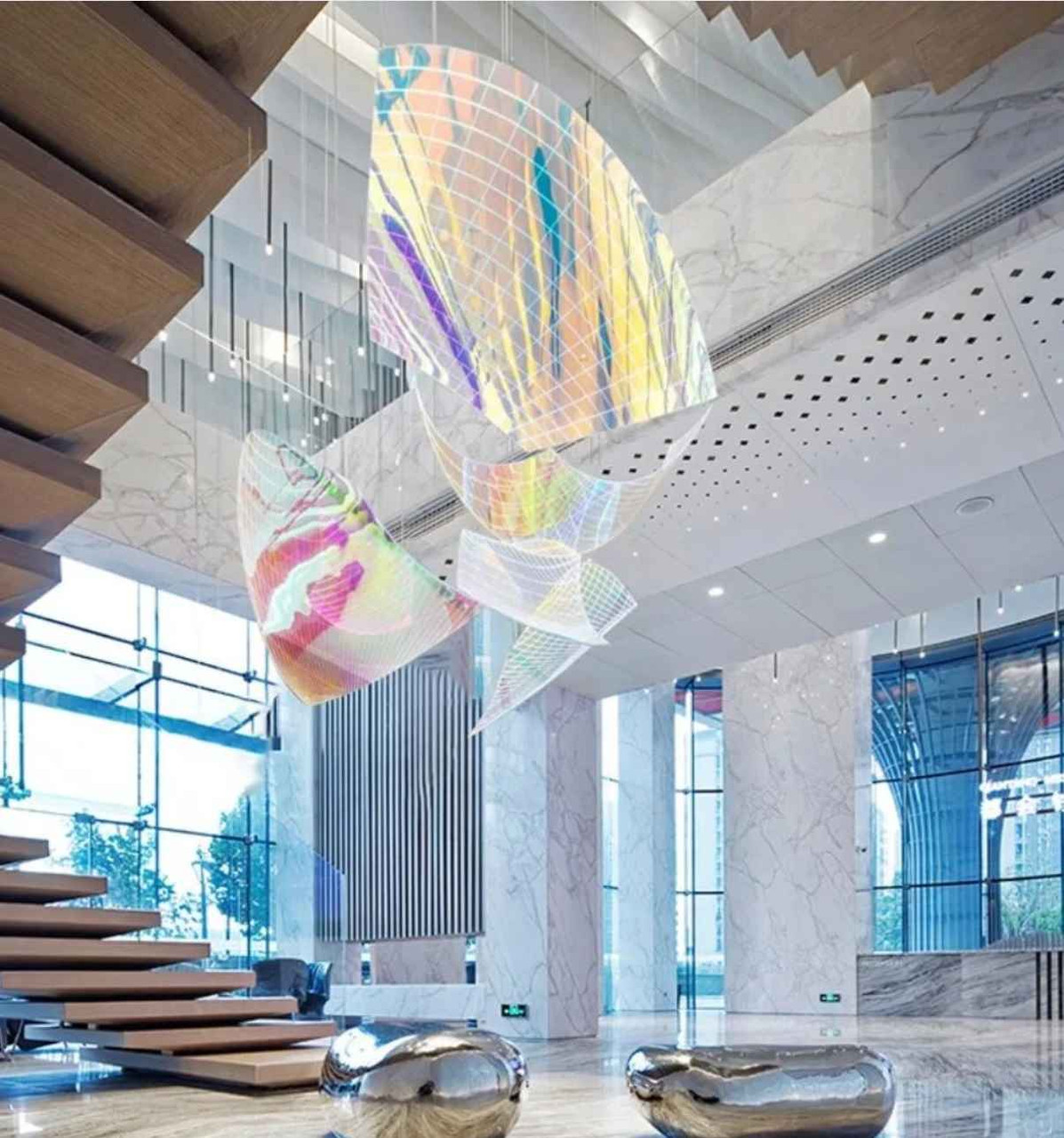The Intersection of Art and Technology: How Holographic Chandeliers are Transforming Modern Interior Design
Aug 18, 2024
The Intersection of Art and Technology: How Holographic Chandeliers are Transforming Modern Interior Design
In recent years, the rapid advancements in technology have revolutionized various aspects of our lives, from communication and entertainment to transportation and healthcare. However, one area that has experienced a profound transformation, albeit sometimes less visibly, is interior design. Among the many innovations shaping this field, holographic chandeliers stand out as a prime example of how the intersection of art and technology can create breathtaking new possibilities in modern spaces. These futuristic lighting fixtures are not just sources of illumination; they are a fusion of artistry and cutting-edge technology, reshaping the way we think about interior design. In this article, we will explore the innovative use of holographic technology in chandelier design, discuss its impact on modern interior design, and delve into the artistic possibilities and immersive environments that these fixtures can create in both homes and commercial spaces.
The Evolution of Lighting in Interior Design
To appreciate the significance of holographic chandeliers, it's important to first understand the evolution of lighting in interior design. For centuries, chandeliers have been symbols of luxury and sophistication, gracing the ceilings of palaces, grand ballrooms, and opulent dining rooms. Traditional chandeliers, often adorned with crystals and intricate metalwork, have long been associated with classical elegance and a sense of grandeur. However, as design tastes evolved, so too did the concept of chandeliers.
The 20th century witnessed the rise of modernist and minimalist design movements, which emphasized simplicity, functionality, and clean lines. Chandeliers adapted to these trends, becoming sleeker and more streamlined while still maintaining their role as focal points in interior spaces. The introduction of new materials such as steel, glass, and acrylic allowed designers to experiment with form and function, resulting in chandeliers that were not only visually striking but also versatile enough to complement a wide range of interior styles.
As we moved into the 21st century, technological advancements began to play an increasingly prominent role in lighting design. LED technology, in particular, revolutionized the industry by offering energy-efficient, long-lasting light sources that could be integrated into innovative designs. This paved the way for the emergence of smart lighting systems, where fixtures could be controlled via smartphones or voice assistants, allowing users to adjust the color, intensity, and even the direction of light to suit their preferences.
Yet, despite these advancements, the concept of chandeliers remained relatively grounded in the physical world—until the advent of holographic technology.
The Birth of Holographic Chandeliers
Holography, the technology that enables the creation of three-dimensional images by recording light patterns, has been around since the mid-20th century. Initially developed for scientific and industrial applications, holography has since found its way into various fields, including entertainment, advertising, and art. However, its potential for revolutionizing interior design has only recently begun to be explored.
Holographic chandeliers represent a significant leap forward in the application of holography within the realm of interior design. Unlike traditional chandeliers, which are physical objects made from materials such as glass, metal, and crystal, holographic chandeliers exist as ethereal, three-dimensional light sculptures that can appear to float in mid-air. They are created using advanced projection systems that emit light in precise patterns, forming intricate shapes and designs that can change dynamically based on the user's preferences.
One of the most striking aspects of holographic chandeliers is their ability to blend seamlessly with their surroundings. Because they are not bound by the limitations of physical materials, these fixtures can take on virtually any form, from delicate, lace-like patterns to bold, geometric shapes. They can also be programmed to change color, intensity, and even shape in real-time, allowing them to adapt to different moods, occasions, or design themes.
What is a holographic chandelier?
A holographic chandelier is an innovative lighting fixture that uses holographic technology to create the illusion of a three-dimensional, floating light structure. Unlike traditional chandeliers, which are physical objects made from materials like glass, metal, and crystal, a holographic chandelier consists of light patterns that are projected into the air to form intricate, often dynamic, shapes and designs.
These chandeliers leverage advanced projection systems or holographic displays to produce light patterns that can vary in color, intensity, and even shape, allowing for highly customizable and interactive lighting experiences. The holographic elements can appear to float or move in mid-air, creating an ethereal and futuristic visual effect.
Because they are not constrained by physical materials, holographic chandeliers can take on virtually any form and can be easily adapted to different design aesthetics or themes. This makes them a unique and versatile addition to modern interior design, offering both artistic expression and advanced technological capabilities.
Impact on Modern Interior Design
The introduction of holographic chandeliers has had a profound impact on modern interior design, offering designers and homeowners a new tool for creating visually stunning and immersive spaces. Here are several ways in which these futuristic lighting fixtures are transforming the field:
1. Redefining Space and Perception:
One of the most remarkable features of holographic chandeliers is their ability to redefine the perception of space. Traditional chandeliers, no matter how grand or intricate, are still bound by the laws of physics—they occupy a specific amount of space and have a tangible presence. Holographic chandeliers, on the other hand, can create the illusion of depth and volume without actually taking up physical space. This opens up new possibilities for interior designers, particularly in small or unconventional spaces where traditional chandeliers might be impractical.
For example, a holographic chandelier could be used in a narrow hallway or a compact living room to create the illusion of a larger, more open space. By projecting a three-dimensional light sculpture that appears to float above the room, the chandelier can add a sense of height and dimension without the need for additional floor space. This ability to manipulate perception through light is a powerful tool for designers looking to create dynamic and engaging interiors.
2. Customization and Personalization:
Another key advantage of holographic chandeliers is their inherent flexibility and adaptability. Unlike traditional chandeliers, which are often fixed in design and function, holographic chandeliers can be customized to suit the specific needs and preferences of the user. This level of personalization is achieved through sophisticated software that allows users to control various aspects of the chandelier, including its shape, color, and movement.
For instance, a homeowner could program their holographic chandelier to display a soft, warm glow with delicate, swirling patterns for a cozy evening at home. Alternatively, the same chandelier could be set to emit a vibrant, dynamic light show with sharp, angular shapes for a lively dinner party. This ability to tailor the chandelier's appearance to different occasions or moods adds a new layer of interactivity and engagement to interior design, making the lighting fixture an integral part of the overall experience.
3. Enhancing Artistic Expression:
Holographic chandeliers are not just functional lighting fixtures; they are also works of art in their own right. The use of light as a medium for artistic expression is not a new concept, but holographic technology takes it to new heights by allowing designers to create intricate, three-dimensional sculptures that can change and evolve over time. This opens up exciting possibilities for artists and designers who want to push the boundaries of traditional chandelier design and explore new forms of visual storytelling.
For example, a holographic chandelier could be used to tell a narrative through light, with different scenes or images appearing and dissolving in the air above a dining table or a grand staircase. These dynamic light sculptures could evoke a wide range of emotions, from tranquility and serenity to excitement and wonder, depending on the design and the context in which they are used. This ability to convey meaning and emotion through light adds a new dimension to interior design, making holographic chandeliers a powerful tool for artistic expression.
4. Integration with Smart Home Systems:
As smart home technology continues to evolve, the integration of holographic chandeliers with these systems is becoming increasingly seamless. Many holographic chandeliers can be controlled via smartphone apps or voice commands, allowing users to adjust the lighting to their liking with just a few taps or words. This level of integration not only adds convenience but also enhances the overall user experience, making the chandelier a more interactive and responsive element of the home.
Moreover, the ability to synchronize holographic chandeliers with other smart home devices, such as sound systems, curtains, and climate control, allows for the creation of fully immersive environments. For example, a user could program their chandelier to change colors and patterns in sync with their favorite music or to gradually dim as the evening progresses, creating a seamless transition from day to night. This level of integration further blurs the line between art and technology, making holographic chandeliers a central feature of the modern smart home.
Artistic Possibilities and Immersive Environments
The artistic possibilities of holographic chandeliers are virtually limitless, thanks to their ability to transcend the physical limitations of traditional materials. Here are a few ways in which these fixtures are being used to create immersive environments in both residential and commercial spaces:
1. Creating Themed Environments:
Holographic chandeliers are particularly well-suited for creating themed environments, where the lighting plays a crucial role in setting the mood and reinforcing the overall design concept. For example, in a high-end restaurant with a nautical theme, a holographic chandelier could be designed to resemble a shimmering, underwater scene, with light patterns that mimic the movement of waves and schools of fish. Similarly, in a luxury hotel lobby, a holographic chandelier could evoke the grandeur of a starry night sky, with twinkling lights that gradually shift in color and intensity.
These themed environments not only enhance the visual appeal of the space but also create a memorable experience for visitors, making them more likely to return and share their experience with others. In this way, holographic chandeliers can become powerful tools for branding and marketing, helping businesses to differentiate themselves in a competitive market.
2. Enhancing Cultural and Artistic Spaces:
Cultural and artistic spaces, such as museums, galleries, and theaters, can also benefit from the use of holographic chandeliers. These fixtures can be used to create dynamic light installations that complement and enhance the art on display, adding a new layer of depth and interactivity to the visitor experience. For example, a holographic chandelier could be used to create a light sculpture that interacts with a painting or sculpture, casting different colors and patterns based on the viewer's position or movement.
In theaters and performance spaces, holographic chandeliers can be integrated into stage design to create immersive lighting effects that enhance the narrative and emotional impact of a performance. Whether it's a subtle, atmospheric glow or a dramatic, pulsating light show, these fixtures can add a new dimension to the performing arts, making them an invaluable tool for directors and designers.
3. Elevating Residential Interiors:
In residential interiors, holographic chandeliers offer homeowners a unique way to express their personal style and create a truly one-of-a-kind living environment. These fixtures can be used to highlight architectural features, such as vaulted ceilings or grand staircases, or to create focal points in key areas, such as dining rooms or entryways. By customizing the design and programming of the chandelier, homeowners can create a lighting fixture that reflects their personality and enhances the overall aesthetic of their home.
Moreover, the ability to change the appearance of the chandelier with the touch of a button allows homeowners to experiment with different looks and moods, keeping their interior design fresh and exciting. Whether it's a soft, romantic glow for a cozy evening at home or a bold, modern light show for a social gathering, holographic chandeliers offer endless possibilities for enhancing the ambiance of a space.
Conclusion
Holographic chandeliers represent a groundbreaking fusion of art and technology, offering a glimpse into the future of interior design. These innovative lighting fixtures are not just sources of illumination; they are dynamic, interactive works of art that have the power to transform spaces and create immersive environments. By redefining the perception of space, offering unparalleled customization, and enhancing artistic expression, holographic chandeliers are pushing the boundaries of what is possible in modern interior design.
As technology continues to evolve, we can expect to see even more exciting developments in the field of holographic lighting. From themed environments in commercial spaces to personalized light sculptures in residential interiors, the possibilities are endless. Ultimately, holographic chandeliers are a testament to the power of creativity and innovation, showing us that the intersection of art and technology can lead to truly extraordinary results.




